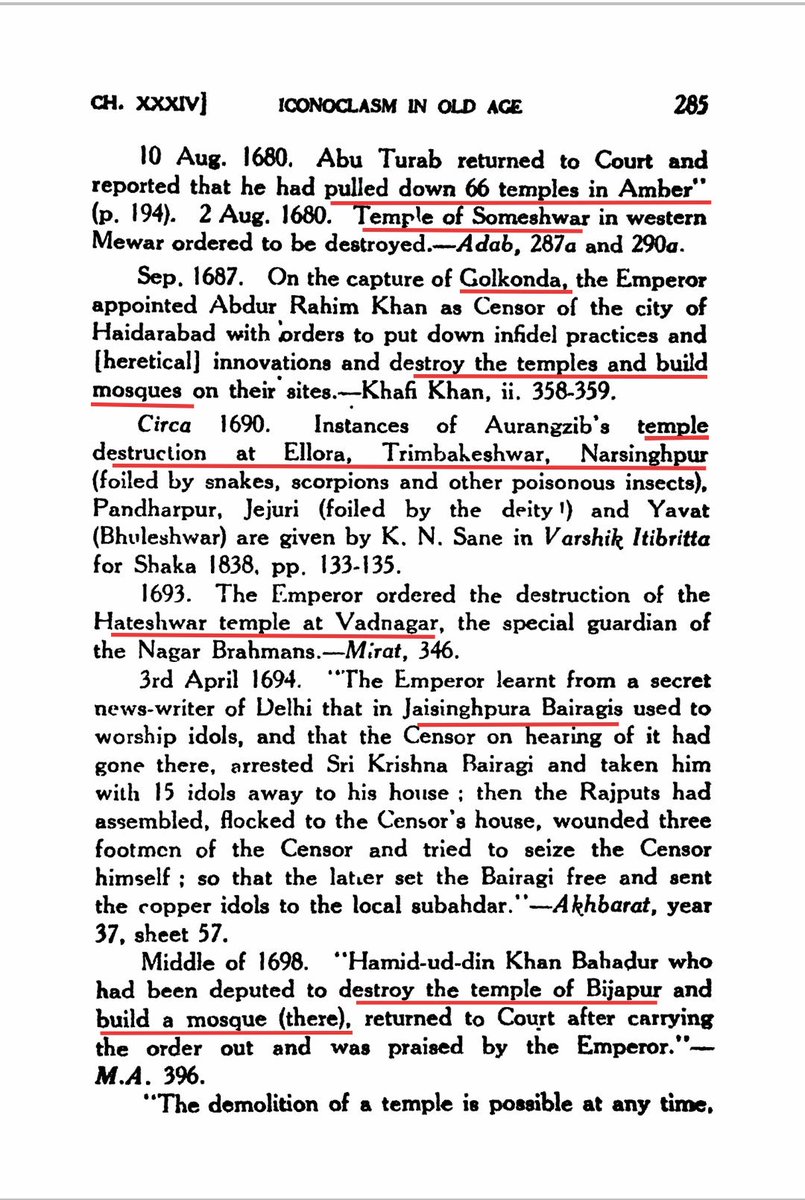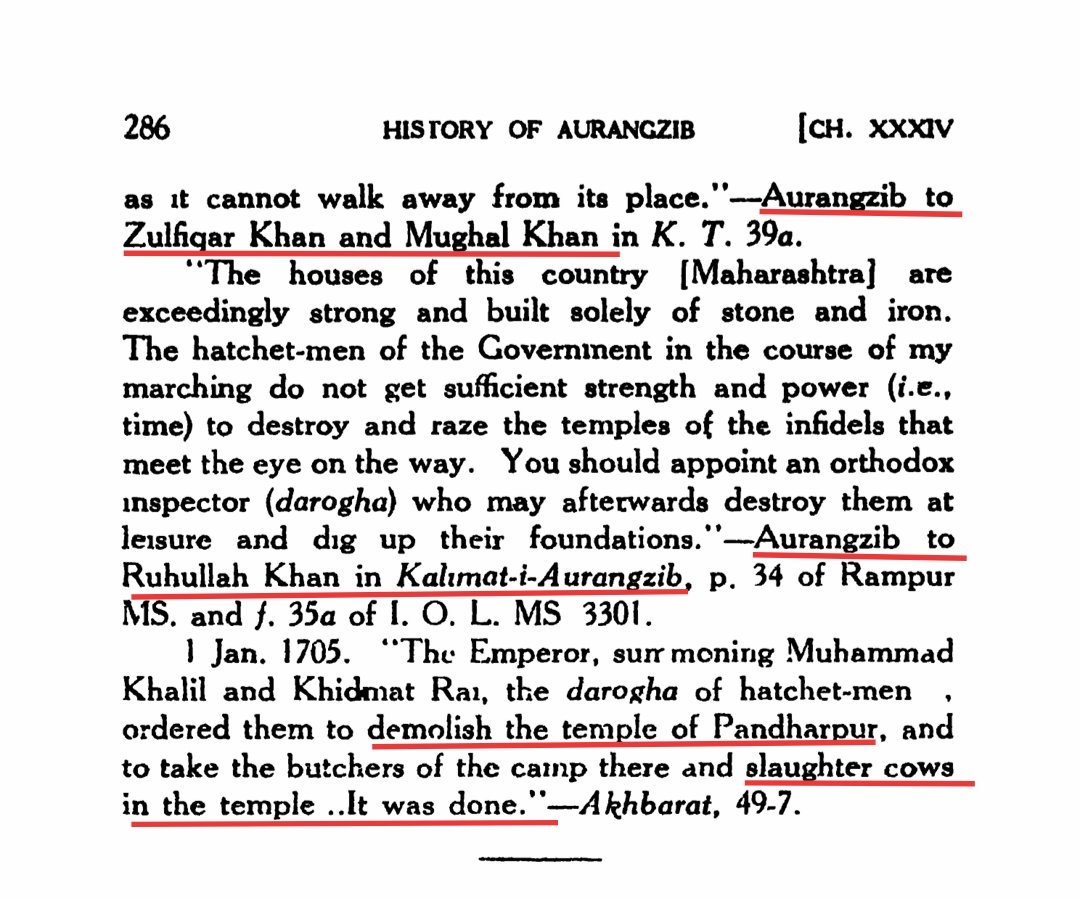Early Marauding barbarian turklutere ravaging town through sudden raids to unknown regions after pillaging everything came in their way to ashes, in the end their leader took one inhabitant as prisoner...
Left distorians tried to portray such "MARAUDERS" as a GREATEST RULERS.
But the truth is exactly opposite as is recorded in this post⬇️
Vulgur and obnoxious leftist propaganda of the primitive tribe of leftist which can.mutate facts to such a level that puts even a worst cancer cell to shame. Not 80 temples were destroyed but 80 Events of such incidents of temple destruction were found....because our own sacred scripture such "Krtya kalpa taru" mentions at least 200 sacred temples which should be visited by pilgrims to Kashi by that time. Ofcourse these were important temples. Add to that all numerous local temples in the locality.....so number of thousand was hardly an exaggeration.
Another incident mentioned in that list is Aurangzeb's invasion of Mewar and Marwar. Here at Udaipur alone he destroyed 173 temples and 63 at Chittor. Again one incident but numerous temple destructions in a single incident!
Now add 80 such incidents and number will cross even more that 60000. More importantly even if only 80 temples would have been destroyed it was grave attack on Dharmic Faiths none the less. They can't settle for a single Babri built on Hindu temple but they accept......Hindus to be fine with destruction of only 80 temples ? ...this creatures are lower than the lowest of creatures crowling on the surface of the Earth when it comes to morality.
Another incident mentioned in that list is Aurangzeb's invasion of Mewar and Marwar. Here at Udaipur alone he destroyed 173 temples and 63 at Chittor. Again one incident but numerous temple destructions in a single incident!
Now add 80 such incidents and number will cross even more that 60000. More importantly even if only 80 temples would have been destroyed it was grave attack on Dharmic Faiths none the less. They can't settle for a single Babri built on Hindu temple but they accept......Hindus to be fine with destruction of only 80 temples ? ...this creatures are lower than the lowest of creatures crowling on the surface of the Earth when it comes to morality.
AURANGZEB appointed officers in all the subdivisions and cities of the empire to enforce the regulations of Islam. The destruction of Hindu temples was one of their chief duties, and large number of officers headed by a "darogha" were employed for the task specifically.
Following are the excerpts from the book "History of Aurangzeb" (mainly based on persian sources), by Jadunath Sarkar.
Mathura has always been the
special victim of Muslim bigotry. The city stood on the king's highway between Agra and Delhi. Aurangzeb's baleful eye had been directed to this holy city very early. He had appointed an orthodox, Abdun Nabi, as faujdar of Mathura to repress the Hindus
Temple of Vishwanath at Benares was destroyed on 2nd Sept, 1669.
January, 1670 :Aurangzeb ordered the demolition of the temple at Mathura known as the Dehra of Keshav Rai. A grand mosque was built on its site at a vast expenditure.
August 1670: Order issued by Aurangzeb on all faujdars of thanas, civil officers (mutasaddis), agents of jagirdars, kris, and almas, from Katak to Medinipur on the frontier of Orissa, to destroy all idol houses built of bricks or clay without delay in entire province of Odisha.
25 May 1679: Khan i-Jahan Bahadur demolished temples in Jodhpur. Aurangzeb ordered that the idols - mostly made of gold silver brass copper or stone and adorned with jewels, should be cast in the quadrangle of the Court and under the steps of Jama Mosque for being trodden upon.
Aurangzeb continued his policy of temple destruction in Amber, Golconda, Ellora, Vadnagar, Bijapur and numerous other sites.



THE EPITOME OF LOVE LORD ALL HAIL THE SHAHJAHAN OF SECULARS
( SHAH E HIND / IMAM E HIND)
In the Mughal capital of Shahjahanabad, mosques occupied commanding positions on the main roads of every neighbourhood. There was no area that had temples and no mosques; not even Hindu populated sections like Katra Neel. This was in accordance with Shah Jahan's decree that "in every lane, bazar, square, and street" a mosque was to be found.
Map of city, dated 1850 CE, showed most of mosques of Shahjahanabad, but provided virtually no information on Hindu, Sikh, and Jain religious edifices.
An archaeological survey conducted in the early twentieth century listed 200 mosques constructed in the city between 1639 and 1857, of which half were built in the Mughal heydays, between 1639 and 1739. No temples were constructed in that period. Fifteen temples were built during the years 1739-1803 when Mughals were no longer dominant; and a record eighty one in the period of British ascendancy in the city, from 1803 to 1857. Even the temples constructed in Shahjahanabad between 1739 and 1857 were all virtually invisible, perhaps the result of a deliberate effort to keep them concealed from public view. There was nothing to even indicate their existence. Most were just small openings, located in private courtyards surrounded by high walls. None of temples built in city in that period had the hallmark shikhara. Digambar Jain Mandir and Gauri Shankar temples were built later. Shikhara in Kalkaji Mandir, Delhi was added in 1816.
WHO SAYS AKBAR WAS SECULAR AND LIBERAL ?
Following excerpts from PN Oak's Book:-
June 1561: Akbar himself led an attack against people of 8 villages in Etah district (Sakit Pargana). In Paraukh village houses were set on fire and about a thousand Hindus were burnt to death. September 1567: Akbar began preparations to invade Chittor. Akbar formed his camp extending for 10 miles of Chittor hill. On February 23, Brave Rajput women performed Jauhar (Self immolation) to escape rape and molestation at the hands of Akbar's barbarous Muslim hordes.
The next morning Akbar rode into the fortress and ordered a general massacre in which 30,000 were slaughtered. Many thousands were taken prisoner to be turned into slaves. The holy threads of those slaughtered, weighed 74.5 maunds. Col. Tod asserts "Generations of martial races (Kshatriyas) were cut off by Akbar's sword. Akbar was long ranked with Shahbuddin, Allauddin and other instruments of destruction, and like these he constructed a Mimbar for Koran from altars of Eklingji (deity of Rajput warriors)."
On November 5, 1556 when Akbar was a mere stripling of less than 14 years of age he slashed the neck of his Hindu adversary, Hemu, brought before him unconscious and bleeding. Vincent Smith
describes this incident as follows:
"...after the fateful battle of Panipat which won the crown of India for Akbar, says Probably Hemu would have won but for the accident that he was struck in the eye by an arrow which pierced his and rendered him unconscious. His army scattered and made no further resistance..."
The story, that a magnanimous sentiment of unwillingness to strike a helpless prisoner already half dead compelled Akbar to refuse to obey his guardian (Behram Khan's instructions to strike a semi conscious enemy), seems to be the late invention of courtly flatterers." This last observation of Smith underlining how flatterers have from time to time falsified history by varnishing their patrons' beastly deeds, needs to be carefully noted by all while reading medieval Muslim chronicles.
Following excerpts from:
The History and Culture of the Indian People, The Mughal Empire - Vol. VII , by RC Majumdar.
During the reign of Akbar, Husain Khan, Governor of Lahore, had decreed that "the Hindus should stick patches of different colours on their shoulders, or on the bottom of their sleeves, so that no Muslim might be put to indignity of showing them honour by mistake. Nor did Husain Khan allow Hindus to saddle their horses but insisted that they use packsaddles when riding. In general, Hindus could not wear rich clothes and ride on fine horses. In Dera Ghazi Khan district a Hindu could ride only on a donkey.
BABUR exempted Muslims from the payment of stamp duties which Hindus alone paid. His officers demolished Hindu temples and constructed mosques in their places at Sambhal, Chanderi, Panipat and Ayodhyā, and broke to pieces Jain idols at Urva near Gwalior. GURU NANAKJI was also an eye-witness to the treatment meted out to the people by BABUR when he invaded India in 1521. Nanak was at Sayyidpur, now called Eminabad, 80 km from Lahore, in the Gujranwala District. BABUR ordered a general massacre of the people and thousands of persons were taken prisoners. The barbarous treatment of prisoners, in the camp, particularly of women, broke the tender heart of NĀNAKJI.
Left Historians' claim : "BABUR WAS A TOLERANT AND LIBERAL RULER"
In Babur-nama, Hindustan is portrayed as a backward civilization.
Here is an excerpt from Baburnama:
In Babur-nama, Rana Sanga is called "Satan-like" and Rana is being repeatedly cursed. The brahmanical thread, which Mughals called Zinar, is mocked in Babur-nama. Babur would refer to Hindus as “kafirs” (english term "pagan") and “termed the war against Rana Sanga as “jihad.”
After the victory over Rajput forces lead by Rana Sanga, Babur assumed the title of 'Ghazi' (victor in the Holy War). He ordered 'to set up a pillar of pagan-heads (heads of martyred Hindu Rajput's) on the infant-hill (kohbacha) between which and the camp, battle was fought'.











No comments:
Post a Comment